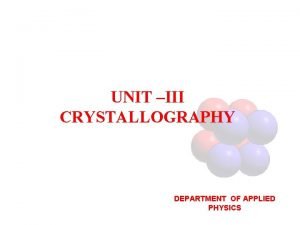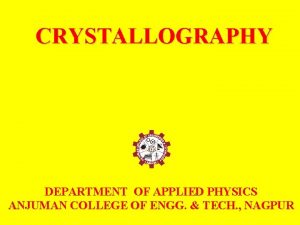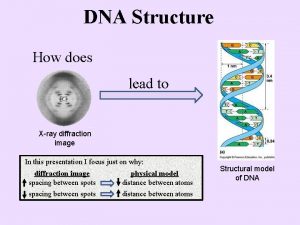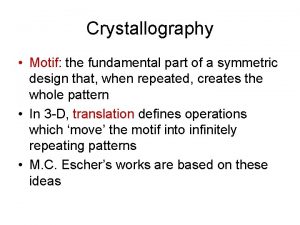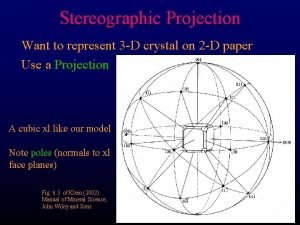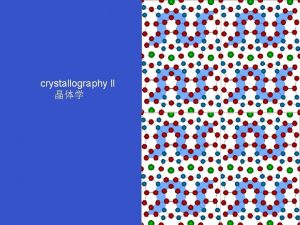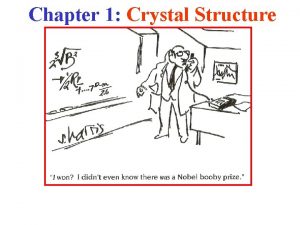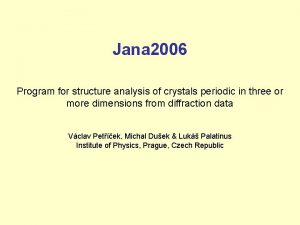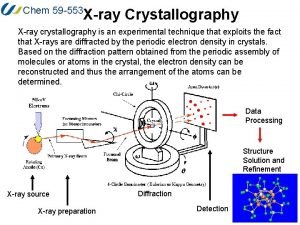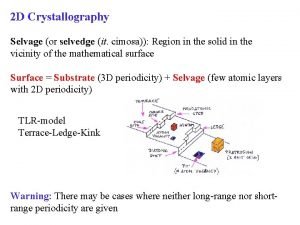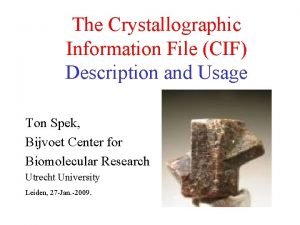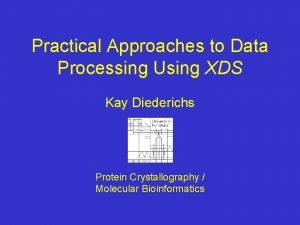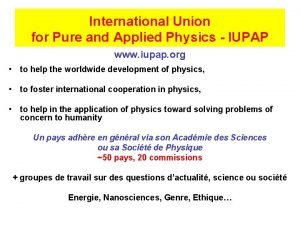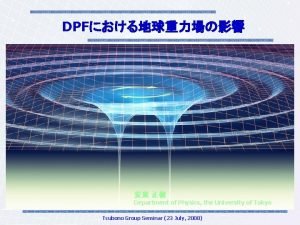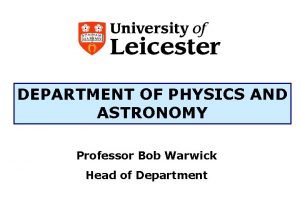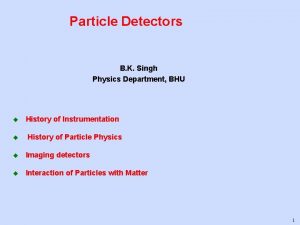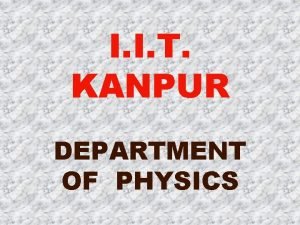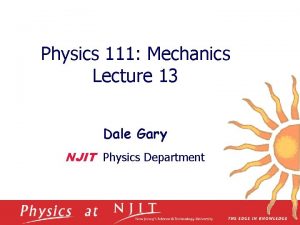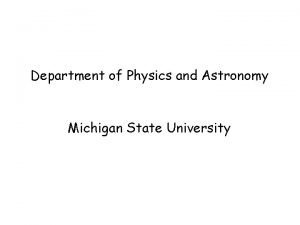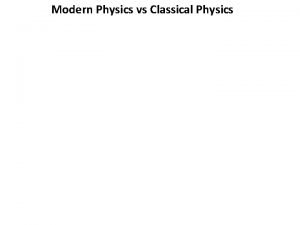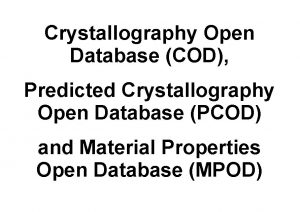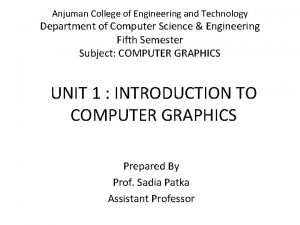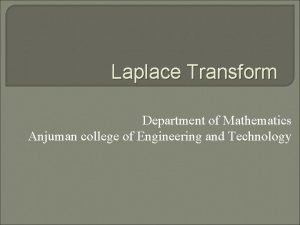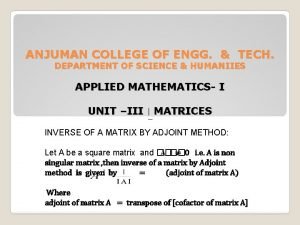CRYSTALLOGRAPHY DEPARTMENT OF APPLIED PHYSICS ANJUMAN COLLEGE OF




















![6. Voids Space Void Space = [1 - APF] x 100 Simple Cubic Cell 6. Voids Space Void Space = [1 - APF] x 100 Simple Cubic Cell](https://slidetodoc.com/presentation_image/335ef5f608eeb4cdcefe9932726dfeae/image-21.jpg)














- Slides: 35

CRYSTALLOGRAPHY DEPARTMENT OF APPLIED PHYSICS ANJUMAN COLLEGE OF ENGG. & TECH. , NAGPUR

SYLLABUS of crystal structure üCrystal structure, Meaning of lattice and basis, Unit cell: primitive and non primitive unit cell; Cubic crystal structure: Body and Face centered cubic structures, SC, BCC and FCC unit cells. üUnit cell characteristics: Effective number of atoms per unit cell, atomic radius, nearest neighbor distance, coordination number, atomic packing fraction, void space, density; üCrystal planes and Miller indices, Inter-planar distance between adjacent planes, ü Bragg‟s law of X-ray diffraction, üTetrahedral and octahedral voids. Crystallography is the experimental science of the arrangement of atoms in solids. The word "crystallography" derives from the Greek words crystallon = cold drop / frozen drop, with its meaning extending to all solids with some degree of transparency, and grapho = write.

The material or solid are classified into three parts, are single crystals, polycrystalline material, amorphous material Single crystals It consist of all atom are arranged in regular manner and identical surrounding. Some materials may have different geometrical shapes, but the angles between the face are always constant. Examples: quartz, rocksalt, alum, diamond etc. .

Polycrystalline It consist of large number of a single crystal of an irregular shape. Majority of the natural solid have polycrystalline structure metals are normally polycrystalline solid. e. g. metal, dielectric, magnetic materials etc. Malleable iron Amorphous Crystal. Grain-oriented electrical steel (grains) Hot-dip galvanized steel. Amorphous solids, which have short range order e. g. glass, polymer, rubber etc Polycristallinesilicon-wafer

Isotropic substance DEFINATION The substances in which physical properties are same along all the direction are called as isotropic substance. e. g. Amorphous material (glass). Anisotropic substance The substance in which physical property change with the direction. Lattice A lattice is a regular periodic arrangement of points in space that looks a net like structure. There are two type of lattice, linear lattice ( Two dimensional) and space lattice (three dimensional) Two dimensional Three dimensional

DEFINATION A vector r passing from the origin to a lattice point can be written as: r = p a +q b +r c (FOR 3 -DIMEINAION) X=pa Y=qb (FOR 1 -DIMENTION) Z=rc Where, a, b, c → basic vectors/Translational vector/primitive • Basis vectors are unit lattice translation vectors which define the coordinate axis (as in the figure below). • Note their length is not 1 unit! (like for the basis vectors of a coordinate axis).

DEFINATION Space lattice A space lattice is defined as an array of point arranged in a regular periodic manner in three dimensional spaces such that each point has exactly identical environment or surrounding. Basis A crystal is form when one or group of atom associated with the lattice point is as basis. A atom or group of atoms identical in composition, arrangement and orientations is called basis + Lattice Sites Basis Crystal Structure

Primitive lattice/u nit cell The unit cell in which only one lattice point are involved called primitive lattice. e. g Simple cubic (SC) Non-Primitive lattice/unit cell The unit cell in which more than one lattice point involved are called non-primitive lattice. e. g. Base centered cubic (BCC) and Face centered cubic (FCC).


Crystal Structure (Unit Cell) • Fundamental block • The unit cell is the smallest geometrical unit , which when repeated in space indefinitely generates the space lattice. • Can be chosen in a number of ways • Is the smallest volume that carries a full description of the entire lattice • Primitive Unit Cell Unit cell is said to be primitive when the cell has lattice points only at its corner. • Non-primitive Unit Cell Non –primitive Unit cell may have the lattice points at the corner as well as at the other locations both inside and on the surface of the cell.

Unit cell • Crystallographic axes : These are the lines drawn parallel to to the lines of intersection of any three faces of the unit cell , which do not lie in the same plane • Lattice constants/Primitives (a, b. c) : The three sides of unit cell are called Lattice constants. • Interfacial angles( α, , ) : The angles between the crystallographic axes of the unit cell are called interfacial angles. • Lattice Parameters : The axial lengths a, b, c, and the three interfacial angles α, , are called as Lattice parameters.

Crystal Systems

Cubic Lattice : The lattice for which the unit cell is a cube , is called a cubic lattice. Simple Cubic (SC) Body Centered cubic (BCC) Face Centered cubic (FCC)

The Unit Cell Characteristics • Unit Cell Volume, V V = abc(1 -cos 2 +2 cos cos ) • • • Effective Number of Atoms per Unit Cell, Z Atomic Radius r Nearest Neighbour distance 2 r Coordination Number, CN Atomic Packing Fraction, APF – APF = Zv / V • Void Space – Void Space = (1 - APF) x 100 • Density = ZM / NAV

CHARACTERISTICS OF UNIT CELLS 1. Unit Cell Volume, V V = a b c (1 -cos 2 +2 cos cos )1/2 For Cubic unit cell a=b= c= & = = =90 hence V = a 3 for SC, BCC & FCC unit cell

2. Effective Number of Atoms per Unit Cell, Z Simple Cubic Cell (SC) Z = 1/8 x 8 ( corners/cell) Z = 1 atom/unit cell Body centered Cubic (BCC) Z = 1(body centre atom/unit cell) +1/8 x 8( corners/cell) Z = 2 atoms/unit cell Face Centered Cubic (FCC) Z = ½ (atom/face) x 6(faces/unit cell) +1/8 x 8( corners/cell) Z = 4 atoms/unit cell

3. Atomic radius , r Simple Cubic Cell (SC) 2 r = a/2 Body centered Cubic (BCC) Body diagonal AG = 4 r AG 2 = AC 2 + CG 2 = (AB 2 + BC 2) + CG 2 (4 r)2 = a 2 + a 2 (4 r)2 = 3 a 2 r =( 3/4) a Face Centered Cubic (FCC) Face diagonal AG = 4 r AC 2 = AB 2 + BC 2 (4 r)2 = a 2 + a 2 (4 r)2 = 2 a 2 r =( 2/4) a = a / (2 2)

4. Nearest neighbour distance, 2 r Simple Cubic Cell (SC) r = a/2 2 r = a Body centered Cubic (BCC) r =( 3/4) a 2 r = ( 3/2) a Face Centered Cubic (FCC) r = a / ( 2 2 ) 2 r = a/ 2

5. Coordination Number, CN Simple Cubic Cell (SC) CN = 6 Body centered Cubic (BCC) Face Centered Cubic (FCC) CN = 8 CN = 12

6. Atomic Packing Fraction Simple Cubic Cell (SC) Body centered Cubic (BCC) Face Centered Cubic (FCC) APF = (Z )/V APF = (Z ) /V For SC cell, Z = 1 For BCC cell, Z = 2 For FCC cell, Z = 4 u=volume of spherical atom u = 4/3 r 3 u= 4/3 r 3 V = volume of the unit cell = a 3 = (2 r)3 = 8 r 3 V = volume of the unit cell = a 3 = (4 r/ 3)3 = 64 r 3 /3 3 V = volume of the unit cell = a 3 = (2 2 r)3 APF = [1 x (4/3 r 3)] / (8 r 3) APF = [2 x (4/3 r 3)] / [64 r 3/ 3 3] APF = [4 x (4/3 r 3)] / [16 2 r 3] APF = /6 = 0. 52 APF = 3 /8 = 0. 68 APF = /3 2 = 0. 74
![6 Voids Space Void Space 1 APF x 100 Simple Cubic Cell 6. Voids Space Void Space = [1 - APF] x 100 Simple Cubic Cell](https://slidetodoc.com/presentation_image/335ef5f608eeb4cdcefe9932726dfeae/image-21.jpg)
6. Voids Space Void Space = [1 - APF] x 100 Simple Cubic Cell (SC) Body centered Cubic (BCC) Face Centered Cubic (FCC) Void Space = [1 -0. 52] x 100 Void Space = [1 -0. 68] x 100 = Void Space = [1 -0. 74] x 100 = 48% 32% = 26%

7. Density = Mass/Volume = ZW/V ; where W = mass of each atom given by M/NA where M is molecular weight of the material and NA is Avogrado number Hence = ZM/(VNA) Simple Cubic Cell (SC) Body centered Cubic (BCC) Face Centered Cubic (FCC) = ZM/VNA for SC, Z = 1 for BCC, Z = 2 For FCC, Z = 4 Hence, = 1 M/(NAa 3) Hence, = 2 M/(NAa 3) Hence, = 4 M/(NAa 3)

Voids • The vacant space between the atoms in the crystal are called voids or interstices • Three dimensional arrangement of spheres gives rise to voids between their curved surfaces • Mainly two kinds of voids in a close packed structure –Tetrahedral –Octahedral

Tetrahedral Void • Produced by a sphere fitting into the valley formed between three adjacent spheres of a closed pack structure. • If centers of four atoms are joined, a regular tetrahedron is produced • The vacant site enclosed by the tetrahedron is called tetrahedral void • If fourth sphere belongs to upper layer- upright tetrahedral void, else, inverted. .

Octahedral Void • Produced when a void formed by three adjacent spheres in one layer comes on the top of the void formed by three spheres in contact in the adjacent layer • Surrounded by six spheres • The centers of the three spheres in a layer comes exactly on the top of the triangular peripheral valleys formed by the spheres in the bottom layer • Octahedron is obtained on joining centers of six spheres, hence space enclosed is called octahedral void

Tetrahedral Two voids per sphere Surrounded by four atoms Smaller in size and greater in number Octahedral One void per sphere Surrounded by six atoms Bigger in size and smaller in number

Miller Indices are the reciprocals of the intercepts made by the plane on the crystallographic axes, when reduced to smallest integers. Procedure for finding the Miller Indices • Identify the intercepts of planes along three crystallographic axes (The coordinates of the points of interception are expressed as integral multiples of the axial lengths in the respective directions) • Determine the reciprocals of the integers • Reduce the reciprocals to the smallest set of integers h, k, l by taking LCM • (h k l) represent Miller Indices

Miller Indices z A G E Plane intercepts 1 ∞ B y reciprocals O F D x C ABCD Miller Indices BEFC ABEG ∞ ∞ 1∞ ∞∞ 1 100 (1 0 0) 010 001 (0 1 0) (0 0 1)

Family of Symmetry Related Planes Z ( 1 1 0 ) ( 1 0 1 ) ( 0 1 1 ) Y ( 1 1 1 ) X ( 2 2 1 )

Interplanar Distance in the Cubic Crystal • Let dhkl represent the distance between two adjacent parallel planes having Miller Indices (hkl) • Let ABC be one of the planes • Perpendicular OD from the origin to the plane = dhkl • Direction cosines of OD: cosα, cos D α OA = a/h OB = a/k OC = a/l O Cosα = OD/OA = hd/a Cos = OD/OB = kd/b Cos = OD/OC = ld/c

Braggs law of X ray diffraction Path difference is Δ =GE + EH For constructive interference Δ =GE + EH = mλ d. sinӨ+d. sinӨ=mλ 2 d. sinӨ =m λ Which is Bragg’s Law

THANK YOU


DEFINATION

HISTORY AND DISCRIPTION �� Developed by William Hallowes Miller �� Describes the orientation of planes in a lattice �� Helps to investigate events in material science
 The silenced by nadia anjuman
The silenced by nadia anjuman Coordination number of fcc
Coordination number of fcc Crystallography engineering physics
Crystallography engineering physics Dna x-ray crystallography
Dna x-ray crystallography Crystallography types
Crystallography types Stereographic projection crystallography
Stereographic projection crystallography Crystallography types
Crystallography types Crystallography types
Crystallography types Jana crystallography
Jana crystallography Crystallography
Crystallography Crystallography
Crystallography Cif crystallographic information file
Cif crystallographic information file Xds data processing
Xds data processing X-ray crystallography
X-ray crystallography Cod crystallography
Cod crystallography Yale applied physics
Yale applied physics Applied physics letters
Applied physics letters Maritime applied physics corporation
Maritime applied physics corporation Johns hopkins applied physics lab internship
Johns hopkins applied physics lab internship Iupap
Iupap Uc college of engineering and applied science
Uc college of engineering and applied science Princeton
Princeton Njit physics
Njit physics Sputonik
Sputonik Warwick physics department
Warwick physics department Bhu physics department
Bhu physics department Iit kanpur physics faculty
Iit kanpur physics faculty Physics 121 njit
Physics 121 njit Michigan state university physics department
Michigan state university physics department Pasadena city college police department
Pasadena city college police department Why does it happen
Why does it happen University physics with modern physics fifteenth edition
University physics with modern physics fifteenth edition Simple physics ia ideas
Simple physics ia ideas College physics explore and apply 2nd edition answers
College physics explore and apply 2nd edition answers Excelsior college physics
Excelsior college physics Asd college college readiness program
Asd college college readiness program

